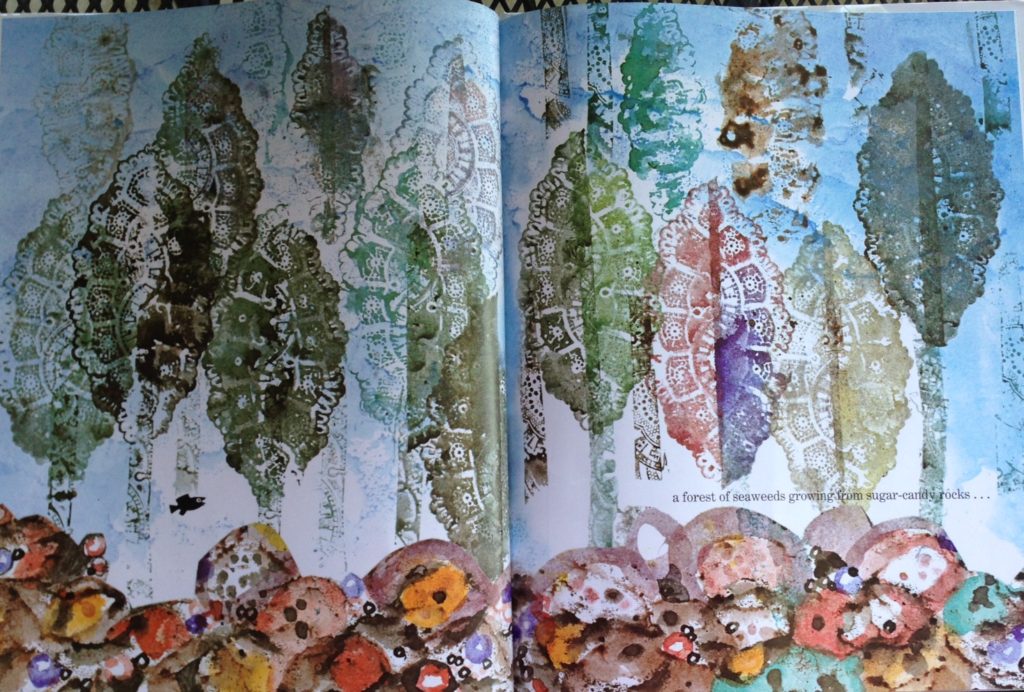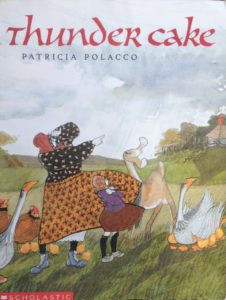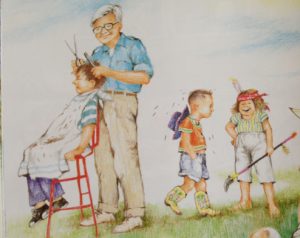 It never ceases to amaze me how a simple little book written for children can offer so much food for thought – for adults.
It never ceases to amaze me how a simple little book written for children can offer so much food for thought – for adults.
1964 Caldecott Honor Book Swimmy, by Leo Lionni, did not disappoint our ESL Book Club. If you are not familiar with the book, I’ve included a video below.
As a Caldecott book, of course we loved the art! That was the first comment made after reading the book. We selected a few of our favorite illustrations:
“He saw a medusa made of rainbow jelly …”
and
“a forest of seaweeds growing from sugar-candy rocks”

Our conversation turned to interpretations of the story. M connected the story to people in her home country standing up against the regime with the words, “Do not be afraid. We are together,” leading us into the theme that, for the weak, there is power and safety when we stand together.
A comment from R surprised all of us a little, I think: “This story is like the story of immigrants. Immigrants have to leave their home and live in a new place, sometimes escaping danger.”
This idea had not crossed my mind as I prepared for book club and when I said as much, several students said they had not made this connection either. But they quickly jumped in with shared experiences as immigrants and many saw themselves as those little red fish “hidden in the dark shade of rocks and weeds” who did not go out and experience their new country, choosing instead the safety of their home.
Y suggested that she was “lazy” in comparison to her friend because she does not get out and do more and expose herself to the bigger world outside her home. E assured her that she is not lazy, but that we progress in our own time. For an immigrant everything is new and it is not always possible to be brave in every new situation.
A shared that when she came to the US, she focussed on what she thought was most important – being independent and doing things on her own. She has learned to practice gratitude every day and now has a much more positive attitude.
We also considered the theme that life goes on after a loss or other bad situation. Although it seems like the author moved quickly to Swimmy’s recovery, we went back and looked at the illustrations. After all the fish in his school were eaten by the big fish, the next illustration is not colorful like the previous pages, but dull and nearly empty.
And then Swimmy begins to notice something beautiful or interesting on each subsequent page. We don’t know how long it took Swimmy to begin to heal, but by the time he reaches the school of red fish who are hiding, he is ready to engage the world: “to go and swim and play and SEE things!”
We also touched on:
* cooperation
* the power of nature to help us heal
* Swimmy taking his place as the eye – the one who sees for the others what is possible
* Swimmy is different in color and speed – sometimes our difference is our strength
* If we think about a problem and do the work, we can solve it.
We had so much to discuss that we never got around to the metaphors and descriptive language that make the story memorable.
One of the students reflected on our discussion by writing the following. My thanks to Ming-I for allowing me to share her words:
My Swimmy
‘Then, hidden in the dark shade of rocks and weeds, he saw a school of little fish, just like his own.
“Let’s go and swim and play and SEE things!” he said happily.
“We can’t,” said the little red fish. “The big fish will eat us all.”
“But you can’t just lie there,” said Swimmy. “We must THINK of something.” ’
——by Leo Lionni, Swimmy
These little red fish triggered the memories of my first two years in Austin. I spent most of the time at home. I only went to the UT apartments ESL classes or visited other housewives living at UT apartments by walking or shuttles. My world was so little, but I hesitated to leave my comfort zone.
Then I met a girl, J. She brought me to various ESL classes and hung out with me in a lot of places l had never been to. She showed me where to take the bus and how to make connection. We always met up on the bus and talked during our rides. She really expended my comfort zone in a friendly way. I appreciated it when I looked back.
I shared my story in the book club while we were discussing the picture book Swimmy. The leader of the book club, Kathy, spoke to me with a flicker of a smile, ”So J is your swimmy!”
“Yes, she is.” I said heartily.
“And she swims.” there is a flicker in Kathy’s eyes.
“I love swimming. I even swim in my dreams.” I recalled J’s own words.
“A happy school of little fish lived in a corner of the sea somewhere. They were all red. Only one of them was as black as a mussel shell. He swam faster than his brothers and sisters. His name was swimmy.”
——by Leo Lionni, Swimmy
As we walked out of the building together, S told Ming-I, “You are my Swimmy!”
I recommend sharing the book Swimmy with ESL students of all ages.
And consider for yourself who has been a Swimmy in your life.
https://www.youtube.com/watch?v=IQlepfKYtUU
And I’ll add the theme image for Sepia Saturday this week – Helsinki residents waiting for evacuation at the railway station. (1939)






